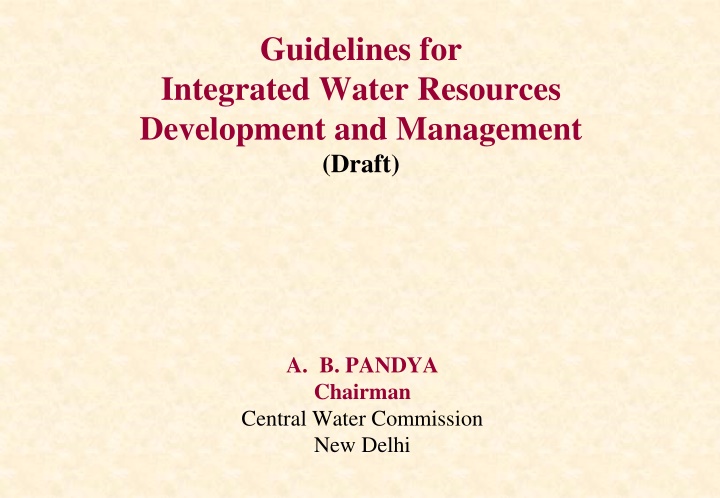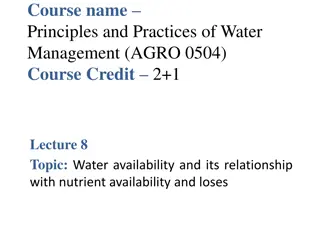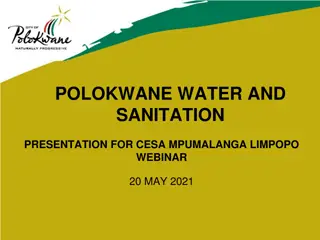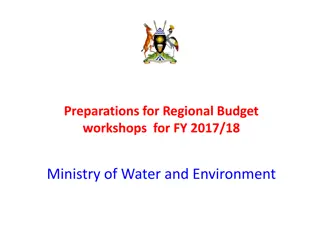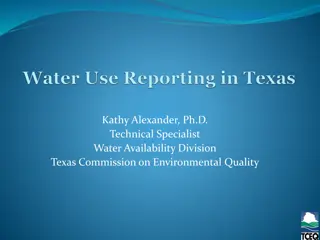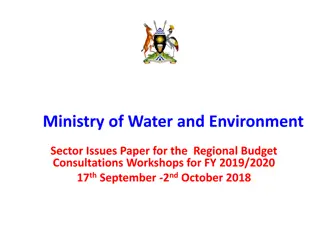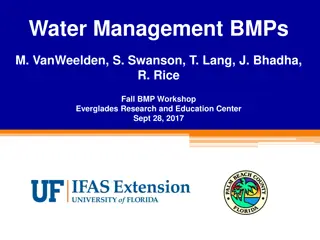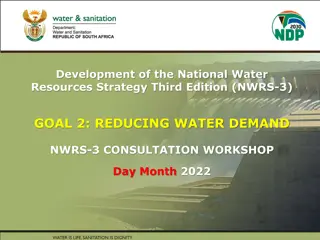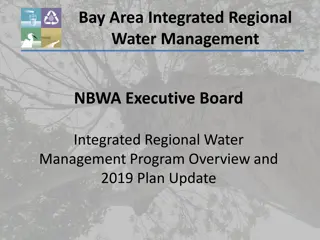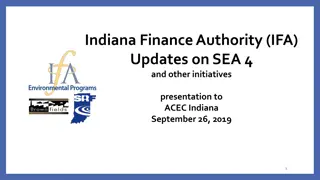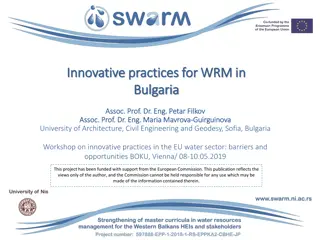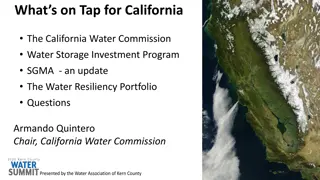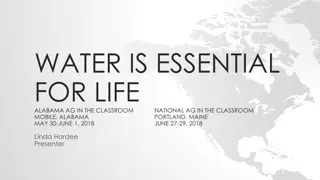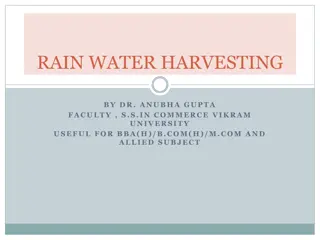Guidelines for Integrated Water Resources Development and Management
The concept of Integrated Water Resources Management (IWRM) aims to address economic efficiency, environmental sustainability, and social equity in water resource management. It involves managing water quantity and quality while promoting societal commitment and public participation. The path to water security includes trade-offs and adaptable governance mechanisms. Implementing IWRM at the river basin level is crucial for sustainable water management and achieving water security for all purposes.
Download Presentation

Please find below an Image/Link to download the presentation.
The content on the website is provided AS IS for your information and personal use only. It may not be sold, licensed, or shared on other websites without obtaining consent from the author.If you encounter any issues during the download, it is possible that the publisher has removed the file from their server.
You are allowed to download the files provided on this website for personal or commercial use, subject to the condition that they are used lawfully. All files are the property of their respective owners.
The content on the website is provided AS IS for your information and personal use only. It may not be sold, licensed, or shared on other websites without obtaining consent from the author.
E N D
Presentation Transcript
Guidelines for Integrated Water Resources Development and Management (Draft) A. B. PANDYA Chairman Central Water Commission New Delhi
INTRODUCTION The concept of Integrated Water Resources Management (IWRM) emerged around the 1980s in response to increasing pressures on water resources from competition amongst various users for a limited resource, the recognition of ecosystem requirements, pollution and the risk of declining water availability due to climate change. IWRM addresses the threeE s : Economic efficiency, Environmental sustainability and social Equity, including poverty reduction. The three basic Pillars of IWRM are the enabling environment of appropriate institutional roles and framework, and the management instruments for these institutions to apply on a daily basis. policies and laws, the
INTRODUCTION(Contd) IWRM addresses both the management of water as a resource, and the framework for provision of water services to all categories of users, and it addresses both water quantity and quality. The basin /Sub-basin must be recognized as the basic unit for planning and management, and a firm societal commitment and proper public participation must be pursued. India has not yet reached the level of Water Resources Development as has already been achieved by many developed countries; therefore, there is a need for India to undertake developmental measures along with management measures A central goal of IWRM at the river basin level is to achieve water security for all purposes, as well as manage risks while responding to, and mitigating disasters.
INTRODUCTION(Contd) The path towards water security requires trade-offs to maintain a proper balance between meeting various sectors needs, and establishing adaptable governance mechanisms to cope with evolving environmental, economical and social circumstances. Well-developed, well-tested, scientifically robust, socially acceptable and economically viable approaches to implement IWRM at the river basin level are still not widely available. IWRM strives for effective and reliable delivery of water services by coordinating and balancing the various water- using sectors this is an important part of sustainable water management.
INTRODUCTION(Contd) Various components involving IWRM and their interaction Basin Basin Organisation Organisation Topography Topography Vegetation Vegetation Geology Geology Climate Climate Human and Organisational Capacity Capacity Human and Organisational Technology Technology Science Based Decision Making Making Science Based Decision Human Water Needs Needs Human Water Availability of fresh water of appropriate quality quality Availability of fresh water of appropriate IWRM IWRM Basin Level Management Activities Activities Basin Level Management Stakeholder Involvement Involvement Stakeholder Aquatic Ecosystem and Biodiversity needs needs Aquatic Ecosystem and Biodiversity Appropriate Flow to Coastal Appropriate Flow to Coastal Areas Areas Policy, Legal and Regulatory Framework Framework Policy, Legal and Regulatory
What Is IWRM? IWRM is a process which promotes the coordinated development and management of land, water and related resources in order to maximize the resultant economic and social welfare in an equitable manner without compromising the sustainability of vital ecosystems . --- Global Water Partnership (GWP-2000)
National Water Policy on IWRM The National Water Policy-2012, in several provisions, has enumerated the integrated perspective of water resources planning, development and management. One of the basic principles of the policy is that planning, development and management of water resources need to be governed by common integrated perspective considering local, regional, State and national context, having an environmentally sound basis, keeping in view the human, social and economic needs.
National Water Policy on IWRM (Contd) There is a need for comprehensive legislation for optimum development of inter- State rivers and river valleys to facilitate inter-State coordination planning of land and water resources taking basin/sub- basin as unit with unified perspectives of water in all its forms (including precipitation, soil moisture, ground and surface water) and ensuring holistic and balanced development of both the catchment and the command areas. Such legislation needs, inter alia, to deal with and enable establishment of basin authorities, comprising party States, with appropriate powers to plan, manage and regulate utilization of water resource in the basins. ensuring scientific
National Water Policy on IWRM (Contd) Highlighting the importance of integrated water resources management, the policy states that Integrated Water Resources Management (IWRM) taking river basin / sub-basin as a unit should be the main principle for planning, management of water resources. The departments / organizations at Centre / State Governments levels should be restructured and made multi-disciplinary accordingly. development and
IWRM-An Evolutionary Process at River Basin Level Important Conditions Basin Management Plan and Vision Participation and Coordination Mechanisms, Fostering Information Sharing and Exchange Capacity Development Well defined Flexible and Enforceable Legal Framework and Regulation Water Allocation Plans Adequate Investment, Financial Stability and Sustainable Cost-recovery Good Knowledge of Natural Resources Present in a Basin Comprehensive Monitoring and Evaluation Political Will and Commitment
Important Conditions (Contd.) A fully integrated approach to manage water in a basin may not be immediately possible. However, this does not prevent embarking on IWRM at the basin level. Various water-related sectors or users should be considered in a well coordinated manner, highlighting the interactions among them, their activities and associated infrastructure. The conditions listed in the last slide are important, but are not a set of necessary prerequisites for implementing IWRM. It aims to create sustainable water security within the present constraints and through improving conditions incrementally in each basin. Water managers should seek and recognize which conditions are essential to effective management, which cannot be readily instituted, and which can be developed wholly or partially over time to progressively move up the spiral.
IWRM AN EVOLUTIONARY PROCESS(Contd) Role of River Basin Organisations RBOs are basin/sub basin level multi-disciplinary organizations comprising of various co-basin State governments and central government so as to promote integrated water resources development and management in the basin/sub-basin. River Basin Organisations (RBOs) support the integrated and physical and technical management of water resources, and, if developed adequately, can respond to the growing competition for water among various State governments and among agricultural, industrial, domestic, and in-stream uses within the basins.
Role of River Basin Organisations(Contd) RBOs can help recognize the environmental impacts of water uses and water development at the basin scale and can effectively take appropriate adaptation measure to climate change. RBOs offer a mechanism to achieve such integrated management by providing the framework for water allocation following efficiency and equity principles and also for resolution of disputes between various stake holders . The integrated approach is widely endorsed and promoted by international organizations as well as by NGOs and scientists though there are few examples of truly integrated RBOs.
Important Directions For IWRM
Water Availability and Requirements There is a need to develop uniform guidelines for assessing water resources potential and assessing water requirements for various uses. Impact of climate change on water resources availability has to be determined along with finding best possible solution in each River Basin. Activities should also improvement of ground water estimation methodology and estimation of ground water withdrawals, based on a total hydrologic system balance. be focused on
Water Rights and Priorities Safe sanitation should be considered as pre-emptive need, followed by high priority allocation for other basic domestic needs (including needs of animals), achieving food security, supporting sustainable agriculture and minimum eco-system needs Water for drinking and
Policy,Legal & Institutional Framework There is a need to evolve a National Framework Law as an umbrella statement of general principles governing the exercise of legislative and/or executive powers by the Centre, the States and the local governing bodies. There is a need for comprehensive legislation for optimum development of inter-State rivers and river valleys to facilitate ensuring scientific planning of land and water taking basin/sub-basin as unit . inter-State coordination
Policy,Legal & Institutional Framework(Contd) State Enactment and Implementation of the Bills for Ground Water Legislation and legislation for Participatory Irrigation Management. The extraction of groundwater in any manner in any area shall be regulated through community based institutions with due regard to the hydro- geological and ecological characteristics and features of the aquifer as a whole. The State Irrigation Acts should be farmer friendly. Governments need to expedite the
Project Planning, Implementation and Prioritization Optimal utilisation of waters within a river basin shall be ensured, with due regard to the reasonable present and future needs for life and livelihoods, appropriate economic activity, social justice and equity, and ecological sustainability. Considering the heavy economic loss due to delay in implementation of projects, all clearances, including environmental clearances, be made time bound. and investment
Project Planning, Implementation and Prioritization(Contd) A project should be considered as having commenced, only after the issue of formal administrative and technical approval by the Government and after clearance by the Technical Advisory Committee. All expenditure incurred prior to this should be shown against investigation and preparation. The approval and implementation of medium projects may be left to the States. It may be laid down that in all such cases, the State proposing the project shall notify it in the Gazette with full details of the parameters laid down by the CWC. If there are objections, within the prescribed period, they should be sorted out mutually or through the Basin Organisations.
Sectoral Issues Domestic Use Urban and rural domestic water supply should preferably be from surface water in conjunction with groundwater and rainwater. Where alternate supplies are available, a source with better reliability and quality needs to be assigned to domestic water supply. Water supply quantity may be seen more as a human development index and made uniform in rural and urban areas.
Domestic Use(Contd) The problem of drinking water in tribal areas are more acute, therefore, to provide accelerated coverage of drinking water to all habitats in tribal areas, an appropriate mechanism should be devised. Water resources projects and services shall be managed with community improved service delivery on sustainable basis, the State Governments / urban local bodies may associate private sector in public private partnership. participation. For
Sectoral Issues(Contd) Irrigation Integrated and coordinated development of surface water and groundwater resources and their conjunctive use should be envisaged right from the project planning stage and should form an integral part for optimum utilisation of water resources. For better water application efficiency, proper design of field application methods as well as new methods, like drip and sprinkler need, to be used. Awareness should be raised among Agricultural Water users in a command area on economical use of precious water, land planning, diversification, harvesting, storage in scientific method and its marketing etc. integrated farming, crop
Irrigation(Contd) There is a need to provide training and skill development of farmers in enhancing effective rainfall for crop production through various agronomic and mechanical measures like adoption of Resource Conservation Technologies, such as land Leveling, Terracing and contour farming, Mulching, Fertigation, water harvesting etc. Planning and execution of all components of irrigation projects including command area development works shall be carried out in a pari-passu manner.
Irrigation (contd) Appropriate guidelines may be laid down for reporting the figures of potential created and the utilization achieved so that there is uniformity in the figures reported . Heavy subsidies in electricity consumed for agriculture have tended to encourage wasteful use of energy and also wasteful use of water. Therefore, it is necessary to gradually reduce the subsidy on power for agriculture. Canal automation is a new technology, which is being introduced in some projects in our country. The performances require to be watched carefully and the modifications, if any, to be incorporated in the future canal automation project identified.
Sectoral Issues(Contd) Flood Control and Management Dams have played a vital role in moderating the inflow flood peaks and also absorbing the floods. Adequate flood-cushion should be provided in water storage projects, wherever feasible, to facilitate better flood management. In highly flood prone areas, flood moderation should be given overriding consideration in reservoir regulation policy even at the cost of sacrificing some irrigation or power benefits. In addition to structural measures, non structural measures also need to be simultaneously taken
Flood Control and Management (Contd) There should be proper coordination between the co- basin states during release of water from upstream states so as to manage flood effectively for the benefit of the inhabitants of the entire basin Possibility and feasibility to divert and store the flood water for later use may be explored
Sectoral Issues(Contd) Hydropower There is an urgent need to evolve suitable strategies for accelerating the pace of hydropower development Unlike other water uses, the planning for power cannot usually be restricted to the demand within a basin alone. The demand for a region or the nation, as a whole, is important rather than demand in a basin. Therefore, the planning should attempt to generate hydroelectric power wherever feasible All water resources projects, including hydro power projects, should be planned to the extent feasible as multi-purpose projects with provision of storage to derive maximum benefit from available topology and water resources
Sectoral Issues(Contd) Industrial Use Actual quantity of water utilized by the major industry should be monitored by government agencies Recycling and reuse of water, after treatments to specified standards, should be incentivised through a properly planned tariff system Private sector participation would be practicable in projects mainly intended for supply for industrial use and urban water supply The concerned State Government and other local bodies should have a coordinated approach in selecting and locating industries of a specific nature with respect to their water requirement and facilities for wastewater disposal.
Sectoral Issues(Contd) Ecology and Other Uses The appropriate Government shall take all measures to protect the ecological integrity necessary to sustain ecosystems dependent on waters Riparian rights of the inhabitants along the river sides should be preserved as prevailed from the ancient times
Ground Water Aspects The approach for groundwater management needs to be multidisciplinary and strongly participatory Aquifers should be identified and mapped at micro level to quantify the available ground water resources and make plans appropriate to the scale of demands and aquifer characteristic. Artificial recharge of ground water is one of the most efficient ground water management tools for ensuring sustainability of ground water resources and should therefore be resorted to wherever possible/feasible. It is essential to ensure the quality of recharge to prevent possible contamination/pollution of aquifer.
Demand Management, Water Pricing and Participatory Management An Independent statutory Water Regulatory Authority shall be established by every State for ensuring equitable access to water for all and its fair pricing, for drinking and other uses The principle of differential pricing for water for drinking and sanitation; and for ensuring food security and supporting livelihood for the poor may be adopted Water charges should be determined on volumetric basis in order to meet equity, efficiency and economic principles.
Demand Management, Water Pricing and Participatory Management(Contd) Water Users Associations (WUAs) should be given statutory powers to collect and retain a portion of water charges, manage the volumetric quantum of water allotted to them and maintain the distribution system in their jurisdiction. Government should progressively transfer management of irrigation command areas to WUAs . Urban and rural water supply as well as supply for other sectors shall be 100% metered and priced on volumetric basis. The rates should be so rationalized that the water intensive crops are charged proportionately more as compared to less water consuming crops.
ENVIRONMENTAL ASPECTS The environmental protection plan, including cumulative environment impact assessment, for an area shall form part of the Master river basin management Plan A catchment treatment programme for arresting the degradation of the catchment areas and restoring ecological balance needs to be planned as part of a project Integrated Watershed development and Management, compensatory afforestation, bio-diversity conservation, wild life conservation, fishery management etc. need to be given due importance.
Rehabilitation and Resettlement Much of the criticism against major developmental projects including water projects emanate from poor R&R, and therefore, R&R of PAPs should receive due attention and should be done in accordance with the provision of the relevant policies/Acts in force . The R&R plan should receive sufficient funds and should be implemented by an independent authority. Implementation of R&R should also be monitored and evaluated by an independent agency. Tribals must be given special attention. They should as far as possible be settled in habitats, closer to the ones left behind by them and without breaking their group identity.
Inter-basin Transfers The approach to inter-basin transfer is that optimal utilization of land and water should first be aimed at, in basins with possible surpluses. Water balance study of the source basin should be undertaken including existing and planning water uses, downstream and interstate requirement, environment needs to decide availability of supply water. Likely impact of climate change may also be considered.
Interstate Issues & International Dimensions Potential conflicting interests in interstate river basins can be overcome through mutual trust and understanding between the States, appropriate legal and institutional frameworks, joint approaches to planning and management, and sharing of the ecological and socio-economic benefits, and related costs. The optimized and integrated international rivers calls for cooperation amongst the co- basin countries There is a need for a joint water resources development programme at basin scale, owned and managed by the riparian countries themselves, in close cooperation with the technical institutions, investment institutions and civil society. development of
Information and Knowledge Management It is necessary to build systematically a data and information system, scientific in approach and comprehensive in coverage, simultaneously with a system of data exchange and information dissemination Data should be shared between departments and levels of government freely other than for the costs of data transfer and made accessible to the public consistent with national security requirements.
RESEARCH AND DEVELOPMENT NEEDS Surface water availability studies need to be refirmed through the modelling of the hydrological cycle using modern technology like Remote Sensing and GIS Research and Development should be closely linked with the needs of the water resources managers and users More research effort needs to be directed towards environmental, legal, socio-economic aspects of irrigation and water resources development and management in general There are several fields where further research is needed for technological innovations such as in environmental flows, sedimentation studies, river morphology, forest hydrology, designs and model studies construction technologies, new materials etc. for specific structures,
RESEARCH AND DEVELOPMENT NEEDS(Contd) It is extremely important that all research results are properly documented and published Benchmarking and performance evaluation of the projects should be given due importance for increasing the performance of existing and future projects Most of the big States have got institutions for research such as Irrigation Research institutes and WALMIs. These need to be made autonomous organisations in order to ensure the continuity of the persons and to give them flexibility in their functions
Draft Guidelines on Integrated Water Resources Development and Management are based on National Water Policy,2012 UNESCO Guidelines on IWRM IWRM and Basin Management Theme (Final Statement) available on www.riob.org/wwf/iwrm basin.pdf Three osnabrueck.de/projects/newater/downloads/newater_rs03.pdf Pillars of IWRM available on www.usf.uni- Guidelines for Preparation of River Basin Master Plan CWC Publication Summary of Recommendations in NCIWRD report (1999) Report of Standing Sub-Committee for Assessment of Availability and Requirement of Water for Diverse Uses in the Country CWC Publication
